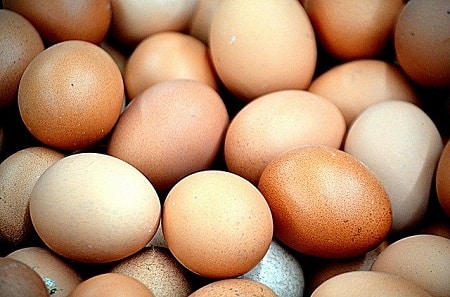Wondering what determines chicken egg color? Or, if there is a way you can tell what color egg a chicken will lay by looking at them?
The good news is that, yes. You can tell what color eggs a chicken will lay by looking at them.
How exactly?
By taking a look at the color of the chicken’s earlobes.
As well as the breed of the chicken. But, it’s the connection between the color of a chicken’s earlobe and the color of the eggshells they produce that’s fascinating.
For example; the most common color of egg is brown. If you look at the hen’s laying these eggs, you’ll notice they have red earlobes.
Breeds with white earlobes, such as the Polish, Minorca, and Leghorn to name a few, lay white eggs.
There are of course some exceptions to the rule. But, as a rule of thumb, you’ll notice there is a strong connection between a chicken’s earlobe color and the color of their eggs.
Table of Contents
How to Tell What Color Eggs a Chicken Will Lay
As I discussed above, if you don’t know enough about a chicken to know what color egg to expect them to lay - just look at their earlobes.
There is a connection between the color of their lobes and the color of eggs they lay.
For example; a lot of people ask which chickens lay blue eggs. For this, you’ll need a chicken with a white earlobe, with a pearly, iridescent shine to name just one kind. There are some blue layers that have red lobes too, so it can get a little confusing.
You can find a chart detailing more than 60 breeds of chicken including the color of their earlobes, eggs, and loads more here.
How Eggs Get Their Color

If you’re curious about how and why eggs are different colors - I know I was - here’s how it works.
Interestingly, all eggs actually start as white in color. By the time they pop out of the hen they will have picked up their color.
As an egg moves down the hen’s oviduct, the passage that runs from their ovary to the outside, it squeezes against glands. As it squeezes against these glands colored pigments are deposited onto the egg to give it its color.
This also explains why some eggs are spotted and some are streaked. If an egg is stationary, it’ll pick up spots. If it’s moving at the time it’ll pick up streaks.
It takes around 26 hours for an egg to complete its journey, and the shell takes around 20 hours to be completed. The pigment only “tints” the surface of the egg too, which is why when you crack one open you’ll see the original white in the inside.
Pretty interesting, eh!
Can One Chicken Lay Different Colored Eggs?
I’ve entered my chicken coop numerous times only to be confused by several shades of brown eggs and wondering who they belong too.
Which raises the question, can one chicken lay different colored eggs?
After doing some research and discussing whether or not chickens can lay different color eggs with the backyard chicken community, the answer is definitely a yes.
It’s not exactly what you’re thinking, though. A single chicken cannot lay completely different colored eggs. It’s more a case that a chicken can lay eggs ranging in shade due to the amount of pigment the egg picked up.
I’ve seen a chicken that lays brown eggs lay eggs ranging in color from light brown and pinkish, to a deep dark brown. Likewise, I’ve seen a hen that produces blue eggs lay eggs ranging from light blue to a greenish color.
This is because there are two different pigments responsible for adding color to eggs.
- Pigment biliverdin, which is responsible for the shades of greens and blues;
- And, pigment protoporphyrin which is responsible for the reddish-brown shades.
A hen can only produce one of these pigments, which is another factor that makes it easier to tell what color eggs they’ll be laying.
It’s further complicated, however, by the fact that if you cross a hen and a rooster from blue and brown laying breeds, you get an “Olive Egger”. Olive eggers lay olive green eggs, a shade somewhere in between brown and blue.
How Many Different Color Chicken Eggs Are There?

If you want to get picky by naming each shade, there are loads of different colored chicken eggs.
For simplicity, however, the color of a hen’s egg is typically put into one of these 5 categories of color:
- White
- Blue
- Green
- Dark Brown
- Pinkish/Cream
There are far too many breeds to list that produce each of these colors. If you’re looking for a specific breed of chicken that produces a certain color egg, it shouldn’t be too hard out which using the information I’ve given you.
Do Different Colored Eggs Taste Different?
This is something that’s been long debated. Do different colored eggs taste different, and if so, which tastes the best?
Well, I hate to be the one to break this to you if this is the first time you’ve heard this. But, the color of an egg doesn’t make any difference to the taste.
Now, I know what you’re going to say as I hear this all the time. You tasted a blue or a green egg once that tasted so much different to a brown egg, right?
I believe you, it’s very likely that you did.
But it wasn’t the color of the egg that made it taste different. It was how the chicken was fed and looked after - that’s what determines the taste of an egg.
If you want proof, put a cheap supermarket egg to a taste test against a free-range chicken egg from a local farmer’s market.
There is literally no comparison, the egg from the farmer’s market looks and tastes so much better. Regardless of what color it is.




